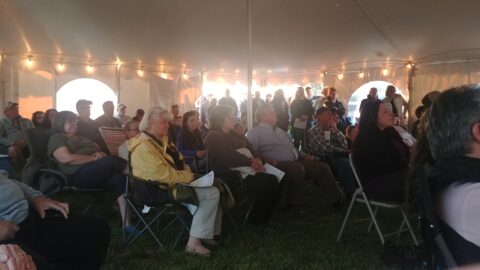I’m sure there are critics who would believe it was appropriate for a conservative-leaning group to meet at the extreme edge of the state, and indeed if you walked across Bethel Road from Range Time you would find yourself in the wilds of Maryland. But the local (and relatively new) indoor gun range was the locale for a tent meeting for the Patriots for Delaware on Tuesday night.

I said a few weeks back that if the Patriots for Delaware found themselves out Laurel way I may have to stop by and see what the fuss was about. Gumboro is close enough, plus I wanted to check out the building anyway. (Alas, I never made it inside.)
One thing I found out is that this group is very creative. I should have taken a couple steps closer to this sign table, but this was meant to be sort of an overall test shot because of the long shadows. Turns out it makes my point.
(Notice they had quite a bit already in the donation box, too.)

“Patriots for Delaware: United in Liberty” (Pretty evergreen.)
“Defund Police? Disarm Citizens? Empower Criminals? No thank you! Vote NO on SB3 & SB6!” (These are “gun control” bills before the Delaware General Assembly.)
“Office Space Available: Contact your Representatives and Senators for Details.” (This refers to the virtual meetings the General Assembly has held since last March.)
They have a lot of good ones besides those for supporting small business, reforming education, and so forth.
One thing I was remiss in capturing was the presence of a couple vendors there as well as a hot dog stand. So there was dinner available if you didn’t mind hot dogs, chips, and a pop.
Here’s another sign that, if the print weren’t so small and the photographer was thinking about it, would give you an idea of where the Patriots for Delaware stand. This was my shot to check lighting in the tent, and unfortunately that was about as good as I was going to get.

Truly, what they had to say was more important than whether I took good photos or not – after all, there were probably 75 to 100 people who took time out of a Tuesday night to attend.

After an opening prayer which beseeched His help for “a nation in need,” we we introduced to the group’s concept by its co-leaders, Glenn Watson, Jr. and Bill Hopkins. This is made necessary because each meeting has such a high proportion of new faces, in part because they move around the state.
The group was “brought about with life, liberty, and the pursuit of happiness in mind,” said Hopkins, who added that the government was not doing its job of guaranteeing it. “If we don’t do something, we’ll have nothing,” Bill continued, noting as well that “we have to forget about this party thing.” Patriots for Delaware was out to attract members from all the parties who agreed on their core concepts.
When it was Glenn’s turn he added that earlier that Tuesday the group was active at the Legislative Hall rally, where they called on our General Assembly to resume public meetings instead of the Zoom meetings that are held inside the hall, with the public locked out. Reopening the legislature was just one of its current priorities, but it also went along with a list of bills they were working to favor or oppose – mostly the latter. (We received a handout of their legislative agenda.)
An interesting sidebar was learning that State Sen. Dave Lawson has been doing the Zoom meetings from his legislative office, with Tuesday’s meeting having the added feature of sign bearers in his background calling on the state to return to “Leg Hall.”
The Patriots for Delaware approach was that of working from the bottom up, which made the slew of school board elections ongoing around the state a key point of interest. The group was in the process of sending out detailed questionnaires to candidates around the state with an eye on endorsing ones they saw fit. There were about three candidates already so endorsed, although none locally.
But there was more to the school boards than just elections. As a rule, their meetings are lightly attended by the public (perhaps by design) but members were working to ferret out waste and abuse of taxpayer dollars. “We need people to make this happen,” said Glenn, so the group was looking for volunteers to attend school board meetings. Something I learned from the chair of their education committee is that the big roadblock to fully opening up schools is the limit in bus capacity.
It should be noted that the first third to half of the meeting was going through committee reports from several of their seven committee chairs. There were actually four other scheduled speakers: the well-received and popular 2020 GOP gubernatorial candidate Julianne Murray, Mike Jones of the U.S. Concealed Carry Association (naturally, since the event was being held at a firing range), Jim Startzman of the Delaware State Sportsmen Association (ditto), and Larry Mayo of the Institute on the Constitution.
Murray, who announced last week she was filing suit in federal court to get the Delaware General Assembly back to meeting in person with public access, noted that while she was glancing behind her to the 2020 election and questions about it, she was more focused on 2022 – an election where we will need hundreds of volunteer poll watchers.
In the meantime, she urged those assembled to beseech the Republicans in the Delaware House to stop HB75, which would allow the DGA to set election terms (basically, codifying a repeat of 2020.) “We’ve got to be smart going into 2022,” she said, “and HB75 is huge.”
Before heading out to tend to a family matter, Murray hinted that her next campaign may not be a second try for governor in 2024, but running against incumbent Attorney General Kathy Jennings next year.
Jones introduced those attending to the USCCA, which provides legal representation to its members in the case of a self-defense incident, while Startzman detailed that his group would be gearing up for lawsuits against the gun grabbing legislation being considered in the General Assembly. For that, they need members and donations.
Mayo revealed that his latest class of IotC graduates would matriculate this week and a new 12-week course would begin next week in Milford. (It’s also available online and on DVD. I guess you don’t get the fancy graduation ceremony.)
Lastly, we had the Q and A portion, which featured an interesting revelation from the aforementioned Councilman Rieley.
Recently Sussex County settled a lawsuit where the plaintiffs contended the county was shortchanging schools because they had not reassessed property since 1974. Rather than fight it, the county agreed to do a three-year assessment at a cost of $10 million.
Of course, people worry about their taxes increasing, but Rieley told those assembled that the goal was revenue neutrality as rates would be reduced. The “maximum” one’s taxes could increase was 10 percent, although he noted some in the western portion of the county may see a decrease. (The increase would likely fall on those in the rapidly-developing eastern half of the county.) Additionally, he promised, “we are not going to be raising taxes anytime soon.” (Then again, for the most part Sussex County simply serves as a pass-through for the state, so they can be blamed.)
I gotta admit, I was a little rusty on the note-taking part of the meeting, but it was an interesting hour and a half that went by quickly. (I couldn’t sleep anyway – it got a bit nippy in that tent once the sun went down.) The next meeting (set for next Tuesday, April 27) isn’t too far down the pike from me in Greenwood, so if my calendar is clear I may head that way. If you are a Delaware resident “barely left of militia” like I am, or even somewhat closer to the center, this is an interesting grassroots group to follow.














